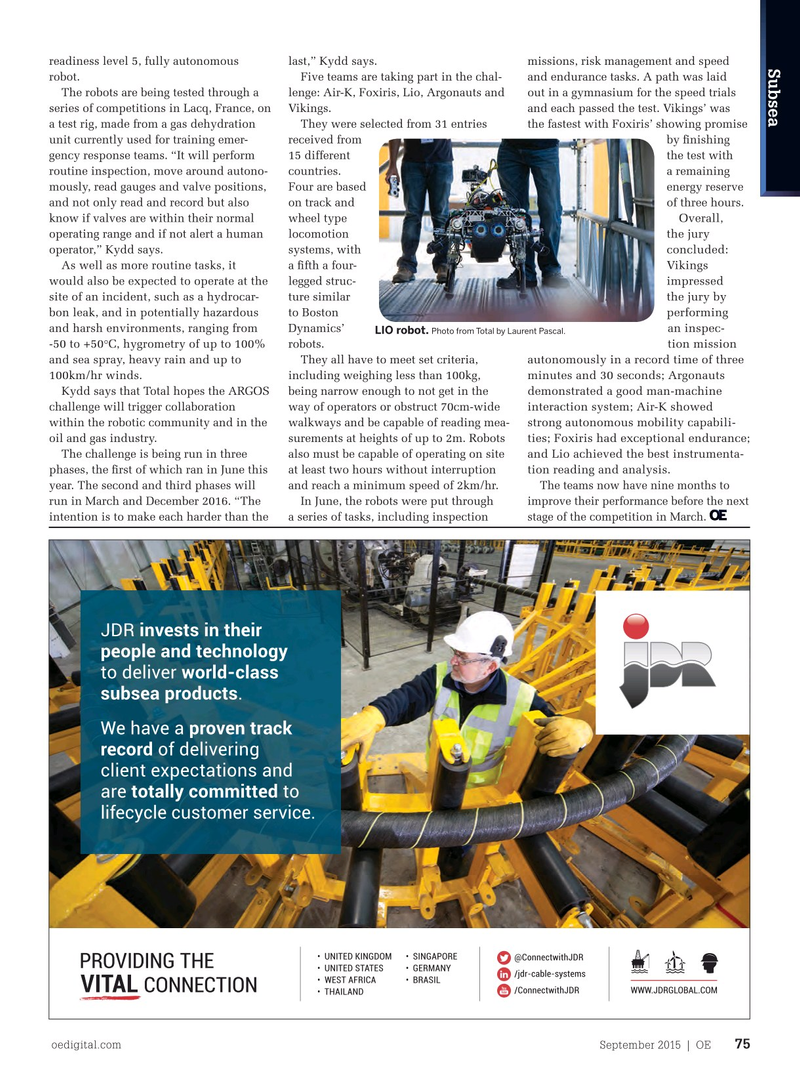
Page 73: of Offshore Engineer Magazine (Sep/Oct 2015)
Read this page in Pdf, Flash or Html5 edition of Sep/Oct 2015 Offshore Engineer Magazine
readiness level 5, fully autonomous last,” Kydd says. missions, risk management and speed
SubseaEyebrow robot. Five teams are taking part in the chal- and endurance tasks. A path was laid
The robots are being tested through a lenge: Air-K, Foxiris, Lio, Argonauts and out in a gymnasium for the speed trials series of competitions in Lacq, France, on Vikings. and each passed the test. Vikings’ was a test rig, made from a gas dehydration They were selected from 31 entries the fastest with Foxiris’ showing promise unit currently used for training emer- received from by ? nishing gency response teams. “It will perform 15 different the test with routine inspection, move around autono- countries. a remaining mously, read gauges and valve positions, Four are based energy reserve and not only read and record but also on track and of three hours.
Overall, know if valves are within their normal wheel type the jury operating range and if not alert a human locomotion concluded: operator,” Kydd says. systems, with
Vikings
As well as more routine tasks, it a ? fth a four- impressed would also be expected to operate at the legged struc- the jury by site of an incident, such as a hydrocar- ture similar performing bon leak, and in potentially hazardous to Boston an inspec- and harsh environments, ranging from Dynamics’
LIO robot. Photo from Total by Laurent Pascal.
tion mission -50 to +50°C, hygrometry of up to 100% robots. autonomously in a record time of three and sea spray, heavy rain and up to They all have to meet set criteria, minutes and 30 seconds; Argonauts 100km/hr winds. including weighing less than 100kg, demonstrated a good man-machine
Kydd says that Total hopes the ARGOS being narrow enough to not get in the interaction system; Air-K showed challenge will trigger collaboration way of operators or obstruct 70cm-wide strong autonomous mobility capabili- within the robotic community and in the walkways and be capable of reading mea- ties; Foxiris had exceptional endurance; oil and gas industry. surements at heights of up to 2m. Robots and Lio achieved the best instrumenta-
The challenge is being run in three also must be capable of operating on site tion reading and analysis. phases, the ? rst of which ran in June this at least two hours without interruption
The teams now have nine months to year. The second and third phases will and reach a minimum speed of 2km/hr. improve their performance before the next run in March and December 2016. “The In June, the robots were put through stage of the competition in March.

 72
72

 74
74